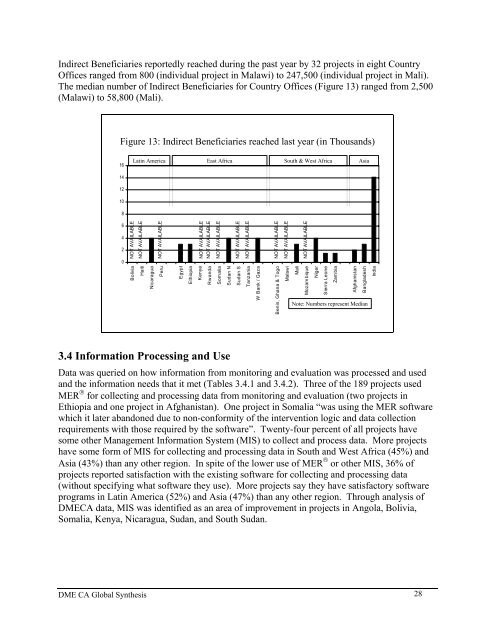Design, Monitoring, and Evaluation – Capacity Assessment
Design, Monitoring, and Evaluation – Capacity Assessment
Design, Monitoring, and Evaluation – Capacity Assessment
You also want an ePaper? Increase the reach of your titles
YUMPU automatically turns print PDFs into web optimized ePapers that Google loves.
Indirect Beneficiaries reportedly reached during the past year by 32 projects in eight Country<br />
Offices ranged from 800 (individual project in Malawi) to 247,500 (individual project in Mali).<br />
The median number of Indirect Beneficiaries for Country Offices (Figure 13) ranged from 2,500<br />
(Malawi) to 58,800 (Mali).<br />
Figure 13: Indirect Beneficiaries reached last year (in Thous<strong>and</strong>s)<br />
16<br />
14<br />
12<br />
10<br />
8<br />
6<br />
4<br />
2<br />
0<br />
NOT AVAILABLE<br />
Bolivia<br />
Latin America East Africa South & West Africa Asia<br />
NOT AVAILABLE<br />
Haiti<br />
Nicaragua<br />
Peru<br />
Egypt<br />
Ethiopia<br />
NOT AVAILABLE<br />
NOT AVAILABLE<br />
3.4 Information Processing <strong>and</strong> Use<br />
NOT AVAILABLE<br />
Kenya<br />
Rw<strong>and</strong>a<br />
NOT AVAILABLE<br />
Somalia<br />
Sudan N<br />
NOT AVAILABLE<br />
Sudan S<br />
NOT AVAILABLE<br />
Tanzania<br />
W Bank / Gaza<br />
NOT AVAILABLE<br />
Benin, Ghana & Togo<br />
NOT AVAILABLE<br />
Malawi<br />
Mali<br />
NOT AVAILABLE<br />
Mozam bique<br />
Niger<br />
Sierra Leone<br />
Zam bia<br />
Afghanistan<br />
Bangladesh<br />
Note: Numbers represent Median<br />
Data was queried on how information from monitoring <strong>and</strong> evaluation was processed <strong>and</strong> used<br />
<strong>and</strong> the information needs that it met (Tables 3.4.1 <strong>and</strong> 3.4.2). Three of the 189 projects used<br />
MER ® for collecting <strong>and</strong> processing data from monitoring <strong>and</strong> evaluation (two projects in<br />
Ethiopia <strong>and</strong> one project in Afghanistan). One project in Somalia “was using the MER software<br />
which it later ab<strong>and</strong>oned due to non-conformity of the intervention logic <strong>and</strong> data collection<br />
requirements with those required by the software”. Twenty-four percent of all projects have<br />
some other Management Information System (MIS) to collect <strong>and</strong> process data. More projects<br />
have some form of MIS for collecting <strong>and</strong> processing data in South <strong>and</strong> West Africa (45%) <strong>and</strong><br />
Asia (43%) than any other region. In spite of the lower use of MER ® or other MIS, 36% of<br />
projects reported satisfaction with the existing software for collecting <strong>and</strong> processing data<br />
(without specifying what software they use). More projects say they have satisfactory software<br />
programs in Latin America (52%) <strong>and</strong> Asia (47%) than any other region. Through analysis of<br />
DMECA data, MIS was identified as an area of improvement in projects in Angola, Bolivia,<br />
Somalia, Kenya, Nicaragua, Sudan, <strong>and</strong> South Sudan.<br />
DME CA Global Synthesis 28<br />
India
















![CynefinFramework final [Read-Only]](https://img.yumpu.com/19017304/1/190x135/cynefinframework-final-read-only.jpg?quality=85)